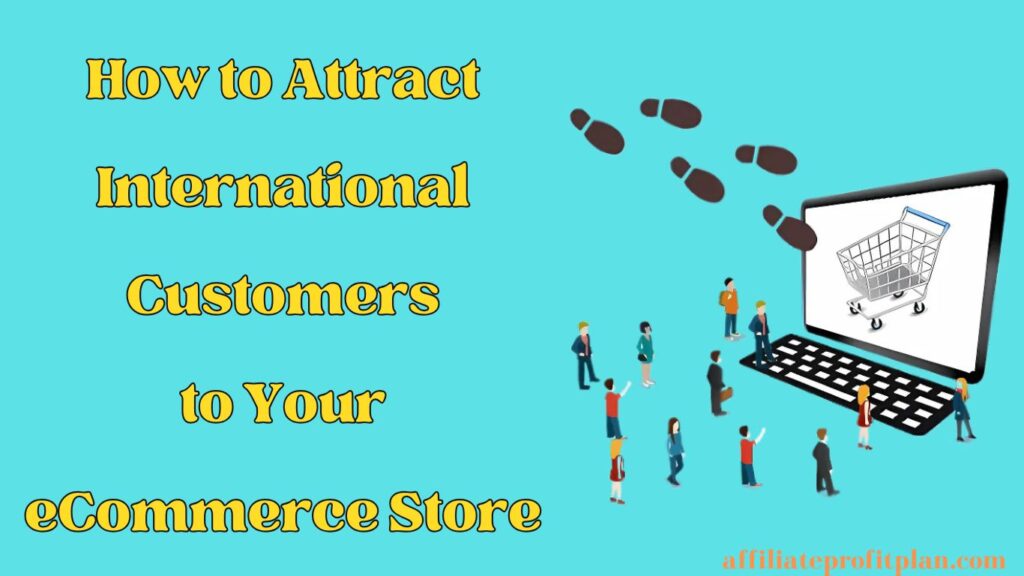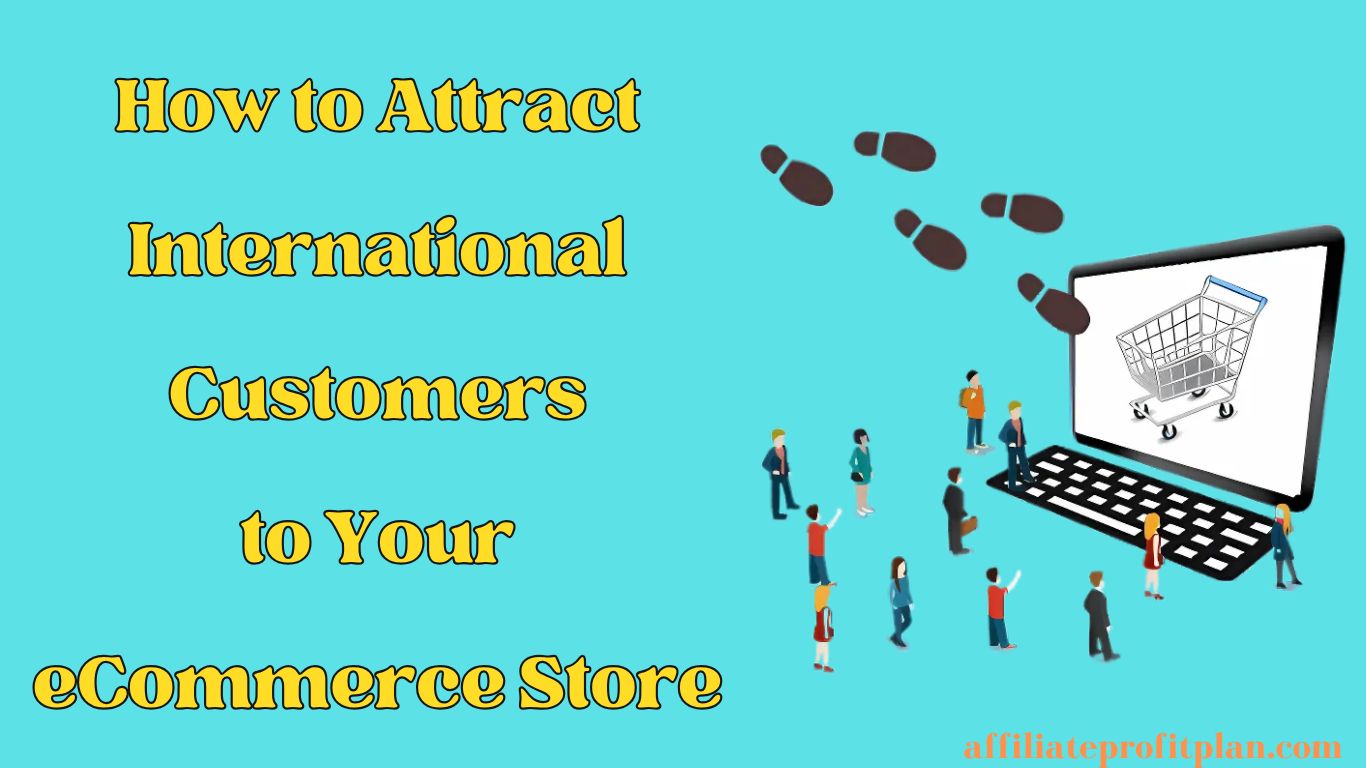Welcome to my article How to Attract International Customers to Your eCommerce Store. Expanding your eCommerce store to attract international customers isn’t just about slapping a “We Ship Worldwide” sticker on your homepage and hoping for the best. In fact, if that’s your strategy, you might find your global ambitions falling flat faster than a package lost in transit. Attracting international buyers requires more than just global shipping—it demands thoughtful planning, localization, and a keen understanding of how to meet the unique needs of customers from different cultures and countries.
In this article, we’ll walk you through the essential steps to attract international customers to your eCommerce store—whether you’re looking to expand into a new region or finally give your current international buyers the shopping experience they deserve. From setting up international shipping to crafting localized marketing campaigns, we’ve got all the tips you need to start growing your global customer base today. Buckle up, because your eCommerce store’s international debut is about to take off!
Access My Proven Blueprint for $50-$100 Daily Income – Watch This FREE Video Now >>>

Optimize Your eCommerce Website for International Shoppers
When it comes to attracting international customers to your eCommerce store, your website is your global storefront. But, much like you wouldn’t expect to stroll into a shop in Tokyo and be greeted in English (unless, of course, you’re in a tourist hotspot), you can’t expect international shoppers to navigate your site in a language or currency that’s inconvenient for them. Optimizing your eCommerce website for international shoppers is a game-changer that can significantly improve your conversion rates and make your brand feel like a local favorite in far-flung markets.
First and foremost, language is key. If you want to sell to customers in France, you better make sure your product descriptions, buttons, and checkout process are in French. But here’s the catch—don’t rely on free online translators like Google Translate for a professional impression. A well-localized site goes beyond simple translation. You’ll need to account for local slang, regional preferences, and culturally relevant nuances. For example, in the U.S., you might call it a “sweater,” but in the UK, it’s a “jumper”—the small things matter.
Next up, currencies and payment methods. No one wants to struggle with currency conversion or worry about hidden fees when checking out. Display prices in the local currency so customers can easily understand how much they’re paying without having to mentally calculate exchange rates. On top of that, offering popular local payment methods—like Alipay in China or Klarna in Sweden—helps reduce friction and build trust. Keep in mind, some regions prefer certain payment methods over credit cards, so offering a mix of options can make all the difference.
Don’t forget the mobile experience! We all know that mobile shopping is booming, and it’s even more crucial for international customers, especially in markets where smartphones are the primary way people shop online. Your website must be mobile-friendly, load quickly, and offer smooth navigation for users on all devices. Slow load times or a janky mobile experience could cost you customers faster than you can say “abandoned cart.”
Finally, let’s talk about shipping. International customers are much more likely to make a purchase if they know exactly what shipping options are available, how much it costs, and when they can expect their package. Display transparent shipping fees and delivery timelines, and offer a variety of shipping methods, from budget-friendly to expedited, so customers can choose what works best for them.
By optimizing your website for international shoppers, you’re not just making a few tweaks—you’re showing your customers that you understand their needs, you respect their preferences, and you’re ready to serve them like a local business. That’s the kind of experience that turns casual browsers into loyal international customers.
Localize Your Marketing and Branding for Global Audiences
If you’ve ever traveled to a foreign country, you know that navigating cultural nuances is a lot like trying to unlock a secret level in a video game. What works in one place might completely flop in another. The same goes for your marketing and branding. To attract international customers, you need to ensure your messaging resonates with people from different backgrounds, cultures, and countries. That’s where localization comes in. It’s not just about translation—it’s about adapting your marketing and branding to fit the unique preferences, values, and expectations of each target market. So, how can you tailor your strategy for a global audience without sounding like you’re trying too hard? Let’s dive in!
First, let’s talk about language again (yes, it’s that important). Translating your product descriptions and website copy is the bare minimum, but if you really want to connect with international customers, you need to go beyond the basics. Think about local idioms, humor, and references that would make your message more relatable. For example, a “cool” product might be perceived as trendy in one country but as simply “chilly” in another. It’s crucial to work with professional translators who understand local dialects and can add flavor to your messaging while keeping it accurate.
Beyond language, consider the cultural values and preferences of your target market. What works in one country might be a deal-breaker in another. For instance, in Japan, where politeness and respect are key, your marketing might need to emphasize humility and customer service. In contrast, in the U.S., bold and direct messaging might resonate better. Local holidays, festivals, and traditions are also a huge part of how people connect with brands. Capitalize on these moments with special offers, themed products, or relevant campaigns that align with the local culture. For example, offer a big sale during the Chinese New Year or promote a specific product during Brazil’s Carnival. These culturally tailored campaigns show that you’re not just a brand selling products—you’re a brand that understands and respects the local culture.
One of the most important aspects of localized branding is the imagery you use. Colors, symbols, and even people’s appearance can carry different meanings across cultures. For example, while white symbolizes purity and peace in many Western cultures, it can represent mourning in some Eastern countries. So, when creating advertisements or promotional materials, consider the visual preferences of your target audience. If you’re selling fashion, for example, using models that represent the local demographic can go a long way in making your brand feel more authentic and relatable.
Lastly, don’t underestimate the power of local influencers and partnerships. Collaborating with influencers who have local credibility can help you build trust and gain exposure in new markets. These influencers know the audience inside out and can present your products in a way that resonates better than you could ever do from thousands of miles away. Plus, partnering with local influencers allows your brand to feel more organic and less like an outsider trying to fit in.
In the end, localization is about more than just selling a product—it’s about showing your global customers that you see them, you understand them, and you’re ready to meet their needs with the respect and attention they deserve. It’s this level of personalization and cultural awareness that turns international browsers into loyal, long-term customers who are excited to share your brand with their networks. So, take the time to localize your marketing and branding efforts—it’s the secret sauce that can help you thrive in the global marketplace.
Offer Exceptional Customer Support to Build Trust Globally
When it comes to attracting international customers to your eCommerce store, offering exceptional customer support is like laying down a welcome mat that says, “We’ve got your back!” around the world. If you’re expecting to build trust and loyalty from customers across different countries, you need to make sure they feel heard, valued, and supported every step of the way. Think of customer support as your digital handshake—it’s the first impression of how much you care about your global customers’ satisfaction, and let’s be honest, no one likes a limp handshake. So, how do you make sure your customer support is up to global standards? Let’s break it down.
Access My Proven Blueprint for $50-$100 Daily Income – Watch This FREE Video Now >>>
First, let’s talk about accessibility. When you’re running an international eCommerce business, your customers could be shopping at all hours of the day (or night). Time zones can be tricky, but that’s where having a 24/7 support system comes in handy. It’s one thing to have your business hours set for the local time zone, but it’s another to anticipate your international customers’ needs and be there when they need help. Offering around-the-clock support ensures that no matter where your customers are in the world, they don’t have to wait until the next morning to get assistance. Whether it’s a live chat feature, email support, or a robust help center, accessibility is key.
Now, let’s talk language, because this is where things get a little more complicated but definitely worth it. Multilingual support is crucial when you want to build trust with international customers. A customer from Japan might appreciate your product, but if they can’t get assistance in their native language, their trust in your brand could take a dive faster than you can say “lost sale.” Offering support in multiple languages helps bridge the communication gap and shows that you care about providing a seamless experience for customers from different cultural backgrounds. This isn’t just about using Google Translate—investing in professional translators or hiring customer support representatives who are fluent in different languages ensures that your responses are clear, courteous, and accurate. Plus, it helps you avoid any cringe-worthy translation fails. Trust us, your customers will thank you for it.
Next up: responsiveness. Nobody likes waiting for a response, especially when you’re sitting in front of your laptop hoping someone will come to the rescue. Quick response times are a non-negotiable when it comes to building trust globally. Whether it’s resolving a shipping issue or answering a product inquiry, customers need to know you’re on top of things. If a customer in Germany has a question at 2 a.m. their time, the last thing they want is to wait days for a reply. Set clear expectations about response times and work to meet (or exceed) those expectations. Automation tools like chatbots can help provide immediate answers to common questions, but don’t forget the personal touch—people want to feel like a human is on the other side, not a machine.
Let’s not forget the power of proactive support. This means you’re not just waiting for customers to reach out with problems—you’re anticipating potential issues and addressing them before they escalate. This could be as simple as sending an email about potential shipping delays, offering advice on product maintenance, or providing tips on how to get the most out of your products. Customers from different countries will appreciate the extra effort you make to keep them informed, especially when it comes to international shipping or customs. By offering proactive support, you’re not only preventing frustration but also strengthening your relationship with your global audience.
Lastly, let’s talk about social media support. In today’s digital age, customers expect to engage with brands on their preferred platforms, whether it’s Facebook, Twitter, Instagram, or even messaging apps like WhatsApp. Social media is a great channel for building trust and offering timely support, especially when it comes to international customers who may not want to navigate long email threads. Be responsive, polite, and show your personality—it’s a great opportunity to humanize your brand and create a connection with your audience, no matter where they are in the world.
In the end, offering exceptional customer support isn’t just about solving problems—it’s about creating an experience that makes international customers feel valued, understood, and supported. When they know they can trust you to help them with any issue, no matter where they are or when they need it, they’ll be more likely to return, recommend your store to others, and become loyal brand advocates. So, if you want to build trust globally, make sure your customer support goes the extra mile. After all, great support equals great relationships—and great relationships lead to global success.
Implement Strategic Pricing for Global Markets
When you’re running an eCommerce store that’s catering to international customers, pricing isn’t just about slapping a number on a product and calling it a day. Oh no, my friend, strategic pricing is a game-changer. It’s like that secret sauce that makes your products irresistible, no matter where in the world your customers are clicking “Add to Cart.” So, how do you set prices that not only appeal to customers across borders but also ensure your profits stay high? Buckle up, because we’re about to dive into the nuances of implementing strategic pricing for global markets!
First, let’s talk about the elephant in the room: currency. If you’re planning to sell internationally, you’re going to need to think beyond your local currency. Some eCommerce platforms allow you to display prices in multiple currencies, which is a fantastic way to eliminate confusion for customers. After all, nobody wants to do mental math to figure out if that $30 sweater is $30 in their currency—or $30 plus a nasty surprise. Providing local currency options helps customers understand exactly what they’re paying, which is a great way to reduce cart abandonment. But currency conversion rates fluctuate, and that can mess with your pricing strategy. To keep things balanced, you’ll need to monitor exchange rates regularly and adjust your pricing to ensure that you’re not underpricing in one market and overpricing in another.
Now, pricing should also reflect local purchasing power. You can’t just expect that the price you charge in the U.S. will translate directly into other countries. What’s affordable in one market may be considered expensive in another. For instance, a product that’s $50 in the U.S. might be too high for customers in emerging markets, while it could be a steal in more affluent countries. You need to consider the local economy, customer income levels, and the competition when determining your pricing. By adjusting your prices according to what’s affordable for customers in each region, you’re more likely to attract the right kind of traffic without leaving money on the table.
Speaking of competition, pricing needs to be competitive, but that doesn’t mean you should always undercut your rivals. It’s about finding that sweet spot where your prices align with both your brand value and what your competitors are offering. Take a look at what other stores are charging for similar products in your target market. Are they offering lower prices but fewer perks? Or are they premium-priced with top-notch customer service? Your pricing should reflect your brand positioning—are you a budget-friendly option, a mid-tier choice, or a luxury item? Knowing this will help you position your products correctly and avoid getting stuck in a race to the bottom where everyone’s competing to be the cheapest.
Next, let’s talk about shipping costs because they can make or break your pricing strategy. Shipping fees, especially international ones, can be a deal-breaker for customers. Imagine your product is priced just right, but when it comes to checkout, your customers are hit with a hefty shipping fee that makes them question their purchase. That’s the kind of shock that’ll send them running to another site. To avoid this, consider including shipping costs in your pricing or offering tiered shipping options—say, free shipping for orders over a certain amount, or express shipping for a premium fee. Offering shipping discounts or free shipping can significantly improve your conversion rate and make international customers feel like they’re getting a deal, no matter where they’re located.
Discounting is another strategic element in pricing for global markets. While everyone loves a good sale, the timing of discounts can vary based on local holidays, traditions, and purchasing habits. For example, Black Friday in the U.S. is a huge sales event, but customers in other parts of the world may not be familiar with it—or they may celebrate a similar event at a different time of year. Localizing your sales promotions to align with regional holidays and events not only boosts sales but also shows customers that you’re in tune with their cultural calendar. Be strategic about when and how you apply discounts, and make sure they’re relevant to the customers you’re targeting.
Finally, let’s not forget about taxes and import duties. When selling internationally, you have to account for any additional costs that may be imposed by customs or government regulations. These fees can vary greatly depending on the country you’re shipping to, and they can sometimes be more than the cost of the product itself. To avoid sticker shock and frustration for customers, be transparent about these potential costs upfront. Consider integrating tax and duty calculators on your checkout page so customers can see an estimate of the total cost before they complete their purchase. This helps manage expectations and prevents abandoned carts when customers see unexpected fees at checkout.
In short, strategic pricing for global markets is all about understanding your customers’ buying behavior, considering the competitive landscape, and being flexible enough to adjust your prices based on local conditions. It’s a delicate balancing act that involves everything from currency conversion to shipping fees, all while ensuring that your pricing aligns with your brand’s value proposition. Nail your pricing strategy, and you’ll not only attract international customers but also turn them into loyal, repeat buyers. So, take the time to research, analyze, and adjust, and watch your global sales soar.
Leverage International Marketing Channels and Partnerships
When it comes to attracting international customers to your eCommerce store, leveraging international marketing channels and partnerships is like having a secret weapon in your global sales arsenal. You’ve already got a killer product, a sleek website, and all the right strategies in place—but now, it’s time to get your brand out there on a global scale. So, how do you tap into markets you may not even be familiar with? Well, buckle up, because we’re about to dive into the world of international marketing channels and partnerships, where the opportunities are as vast as the world map itself.
First up, let’s talk about local social media platforms. While Facebook, Instagram, and Twitter are global staples, there’s a whole treasure trove of region-specific platforms that might just be your ticket to connecting with international customers. For example, WeChat dominates China, and it’s not just for chatting—people use it for shopping, payment processing, and everything in between. In the Middle East, Snapchat and TikTok reign supreme, while in Russia, VKontakte (VK) still has a massive user base. Instead of solely focusing on the usual suspects, consider diversifying your social media strategy to include platforms that are more popular in specific countries. By doing so, you’re not only meeting customers where they already are, but you’re also increasing the chances of your content being seen by the right audience.
But wait, social media is just the beginning. Enter influencer marketing, which is basically the digital version of getting the coolest kid in school to endorse your product. While influencer marketing is huge globally, the rules change from region to region. An influencer who’s hot in New York might not even register in São Paulo. So, to tap into those international markets, partner with local influencers who know their audience inside and out. They can help promote your products in a way that resonates with local customs, language, and trends. Bonus points if you find influencers who can do this while rocking a look that screams “global influencer”—because, let’s face it, we all want to look like we have our finger on the pulse of worldwide cool.
Next, let’s talk about international marketplaces. Amazon is the obvious giant, but depending on where your target audience is, there are plenty of other players who have already built a strong foundation in local markets. Take AliExpress in China, Flipkart in India, or eBay in the UK. These platforms offer massive global reach with built-in trust from their local customer base, which means you don’t have to work as hard to convince potential customers that your brand is reliable. Listing your products on international marketplaces allows you to leverage their established credibility while reaching new audiences. Plus, many of these platforms provide localized services, like translation and currency conversion, making the whole selling process easier for both you and your customers.
But don’t just stop there—think collaborative partnerships with international businesses. You know what they say: teamwork makes the dream work! Partnering with a local business or retailer that already has a strong presence can give your eCommerce store an immediate credibility boost. Whether it’s through co-branded products, bundled offers, or joint promotions, partnerships allow you to expand your reach while relying on a trusted local partner’s market knowledge. It’s like having a local guide in a foreign city—you get to avoid the tourist traps and head straight to the places that matter.
Another effective strategy for building brand recognition globally is cross-border email marketing. However, this isn’t just about sending the same generic emails to everyone. You need to personalize your email campaigns to cater to the unique preferences, holidays, and time zones of your international audience. For example, if you’re targeting customers in India, offering discounts during Diwali might resonate better than a typical 10% off sale. Similarly, sending a special “summer sale” email to customers in Australia during their winter will miss the mark. Be mindful of local customs and buying behaviors, and use email segmentation to send targeted offers at the right time to maximize engagement.
Lastly, don’t forget about local SEO. International SEO isn’t just about translating your website—it’s about localizing it to make sure you’re being found by the right audience. This means using region-specific keywords, optimizing for local search engines (Baidu, Yandex, and others), and creating content that resonates with cultural preferences. This strategy helps you show up when your customers are searching for your product on their own turf, which increases your chances of converting them into paying customers. You’ll want to make sure that your site is tailored to reflect local languages, currencies, and even shipping preferences to provide the best user experience possible. Think of it as getting a personalized recommendation from your local barista, rather than just a generic, one-size-fits-all drink order.
The final piece of the puzzle is global partnerships with payment providers. Let’s face it: people are picky about how they pay for things, and the payment methods that work in one country might not fly in another. For example, while credit cards are king in North America, customers in countries like China and Japan prefer digital wallets or local payment systems. Offering multiple payment options that cater to different regions can go a long way in removing friction from the checkout process and boosting conversions.
In summary, leveraging international marketing channels and partnerships is all about making sure your brand doesn’t just live on the web—it thrives globally. By tapping into region-specific social media, partnering with local influencers, utilizing international marketplaces, and optimizing your marketing efforts for specific cultures, you’ll be able to attract customers from all over the world. Plus, you’ll have the local know-how to back up your global reach, making your store more appealing to international shoppers who value authenticity, local relevance, and tailored experiences. So, get out there and start building your global brand presence—there’s a whole world of customers waiting for you!
Conclusion
To wrap things up, attracting international customers to your eCommerce store isn’t just about adding a “global shipping” option and calling it a day. It’s about diving deep into the local cultures, preferences, and habits of your target markets. By optimizing your website for international shoppers, localizing your marketing, offering exceptional customer support, implementing strategic pricing, and leveraging international marketing channels and partnerships, you’ll not only broaden your reach but also create a loyal, global customer base that feels connected to your brand.
Access My Proven Blueprint for $50-$100 Daily Income – Watch This FREE Video Now >>>
Remember, in the eCommerce world, thinking globally doesn’t mean losing your local touch—it’s about blending the best of both worlds. So whether you’re posting on WeChat, partnering with influencers in Brazil, or offering flexible payment methods for European shoppers, the key is to make every customer feel like they’ve found a brand that truly understands them. The digital world is a big place, but with the right strategies, your eCommerce store can stand out and thrive across borders.
So go ahead, break through those geographic boundaries and watch your business grow. The world is your oyster, and your eCommerce store? Well, it’s the pearl waiting to be discovered!
Thanks a lot for reading my article on “How to Attract International Customers to Your eCommerce Store“ till the end. Hope you’ve helped. See you with another article.










